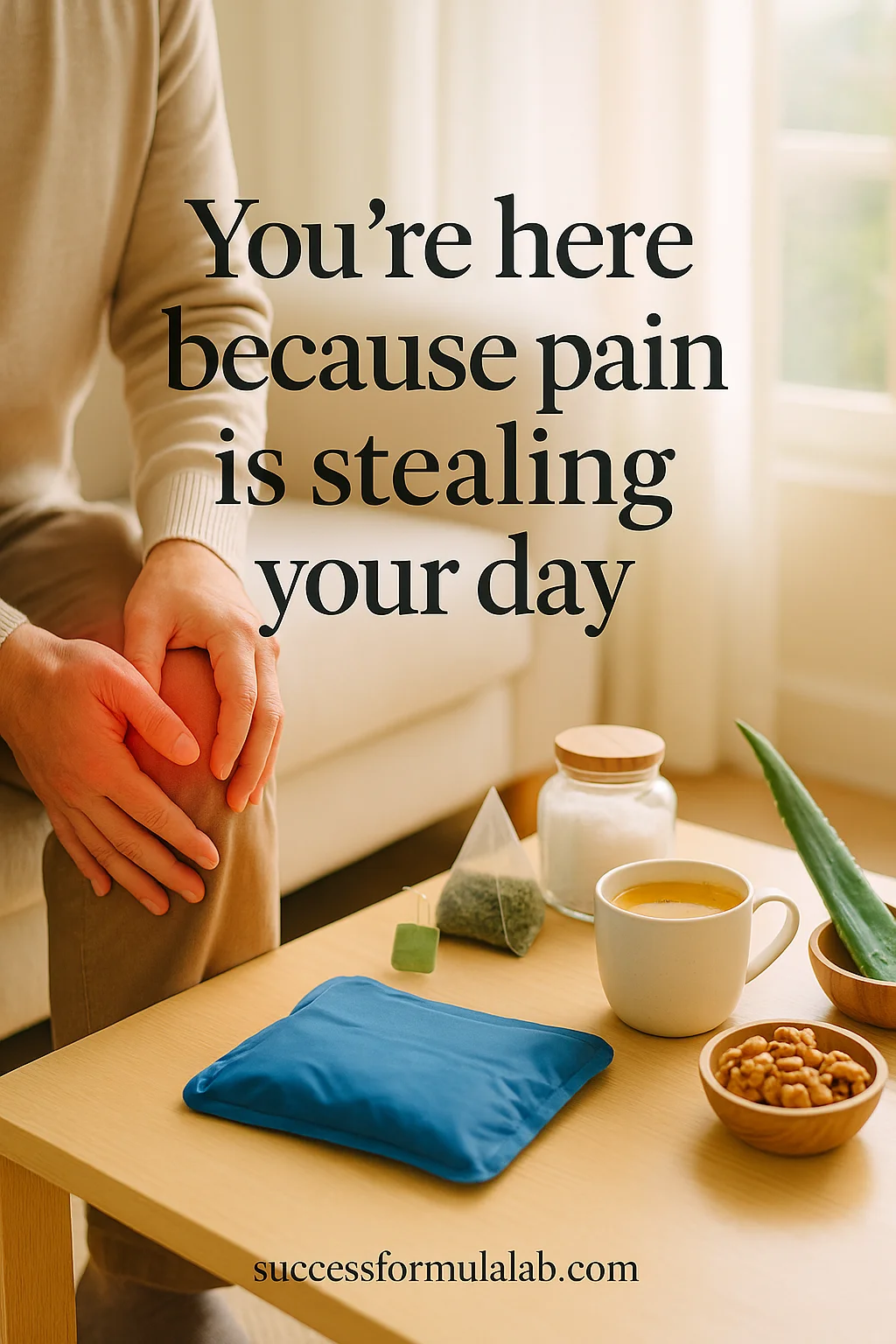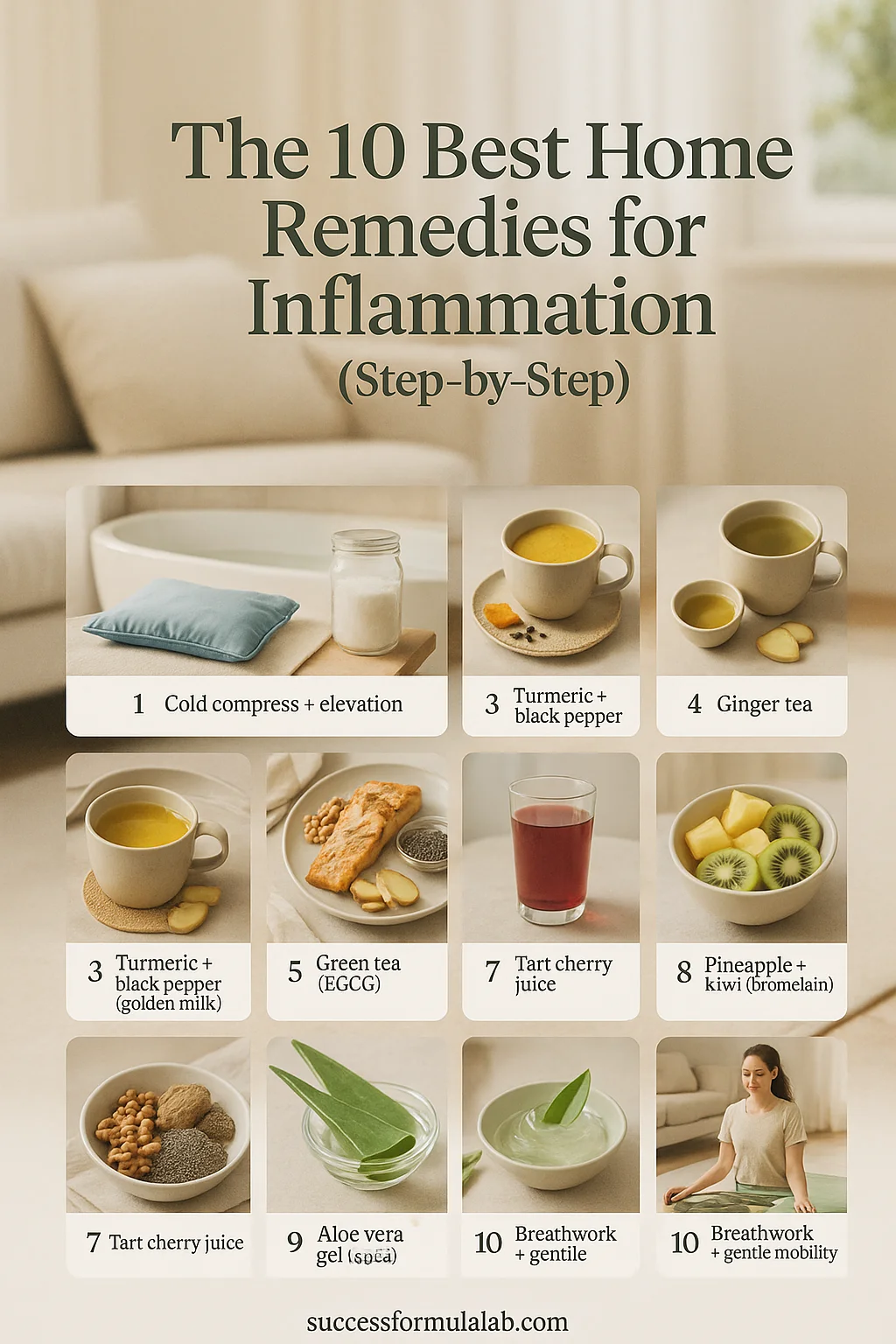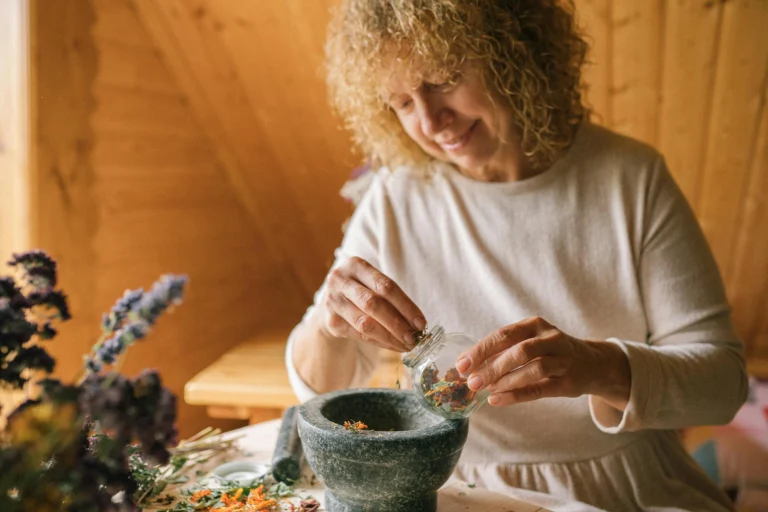You’re here because pain is stealing your day

Maybe your knee flared up after a sprint for the bus. Maybe your wrist is on fire from hours at a keyboard. You want something you can do now—without a pharmacy run—to calm the burn and get back to normal. This guide gives you simple, practical home remedies for inflammation you can use today, plus smart safety notes so you know what helps, what to skip, and when to call a professional.
Helpful resource: If you want reliable, at-home options for soothing herbs like turmeric, ginger, and aloe, consider growing a small backyard apothecary with the Medicinal Garden Kit—it shows you exactly which healing plants to grow and how to use them.
What inflammation is (and when to worry)
Inflammation is your body’s built-in repair mode. In the acute phase—after a twist, bump, or strain—you’ll notice the five hallmarks: redness, heat, swelling, pain, and brief loss of function.
That short-term response protects the area and jump-starts healing.
When low-grade irritation lingers for weeks to months, it becomes chronic and may relate to broader health issues—prompting many to try home remedies for inflammation to ease discomfort between visits.
Use home remedies for inflammation only for mild, self-limited issues; they’re not a substitute for medical care.
Seek urgent evaluation for severe pain, fever, spreading redness, chest pain, shortness of breath, signs of infection, or if swelling/pain don’t improve within 48–72 hours.
Used wisely, home remedies for inflammation can complement treatment and support recovery.
Safety first (read this before you try anything)
-
Med interactions: Turmeric/curcumin, ginger, and bromelain (from pineapple) can interact with blood thinners/antiplatelets. If you take prescription meds or have bleeding disorders, talk to your clinician.
-
Topicals & skin: Patch-test aloe vera and avoid applying to broken skin unless your clinician says it’s okay. Evidence supports aloe for minor burns; more serious burns need medical care.
-
Cold vs. heat: For fresh injuries in the first 48–72 hours, cold is typically preferred; heat comes later for stiffness once swelling settles.
-
Red flags: New weakness/numbness, deformity, intense or worsening pain, or symptoms that don’t improve—get care.
The 10 best home remedies for inflammation (step-by-step)

1) Cold compress + elevation (fastest swelling control)
Best for: fresh sprains, bumps, overuse flares within the first 48–72 hours.
How to do it:
-
Wrap a cold pack (or frozen peas) in a damp cloth.
-
Apply 10–20 minutes at a time, repeat every 2–3 hours.
-
Elevate the limb above your heart between sessions.
Why it helps: Cold narrows blood vessels and can limit early swelling and pain; elevation uses gravity to move fluid out. Avoid direct ice on skin and stop if numbness or burning occurs.
2) Epsom-salt soak (comfort for stiffness, not fresh swelling)
Best for: general stiffness or soreness after the acute window.
Use this mix (H4 recipe table):
| Ingredient | Amount | Notes |
|---|---|---|
| Epsom salt (magnesium sulfate) | 1–2 cups | Dissolve in warm (not hot) bath |
| Warm water | Full tub/large basin | Skip if you have open wounds |
| Optional: lavender oil | 2–3 drops | For relaxation only |
How to use: Soak 10–20 minutes. Pat dry, then gently move the joint through a pain-free range.
Evidence note: Many people find it soothing; research is mixed. Treat it as a comfort add-on, not a cure.
3) Turmeric + black pepper “Golden Milk” (curcumin support)
Curcumin—the key compound in turmeric—has been studied for effects on inflammatory pathways. Black pepper (piperine) can increase curcumin’s bioavailability, which is why you’ll see them paired. Human trials suggest potential benefit for joint comfort, but quality and formulas vary; think of golden milk as a supportive habit, not magic.
H4 recipe: Golden Milk (anti-inflammatory spice latte)
| Ingredient | Amount | Notes |
|---|---|---|
| Milk (dairy or unsweetened plant) | 1 cup | Warm gently, don’t boil |
| Turmeric powder | ½ tsp | Start low if new |
| Black pepper (fresh) | Pinch | Helps absorption |
| Fresh ginger (grated) or powder | ¼ tsp | Optional kick |
| Cinnamon | ¼ tsp | Optional |
| Honey or maple | 1 tsp | Optional, to taste |
Steps: Warm milk → whisk in spices → sweeten to taste → sip slowly in the evening.
Safety: If you’re on anticoagulants or have gallbladder disease, check with your clinician first. NCCIH
4) Ginger tea (comfort for aches and digestion)
Ginger contains gingerols and shogaols, studied for effects on pain signaling. Evidence for arthritis pain is mixed (some positive, some inconclusive), but ginger is widely used for mild aches and post-exercise soreness and is generally well-tolerated in culinary amounts.
recipe: Quick ginger tea
| Ingredient | Amount | Notes |
|---|---|---|
| Fresh ginger, thinly sliced | 6–8 slices | Or ½ tsp powder |
| Water | 1½ cups | Simmer 8–10 min |
| Lemon | 1–2 wedges | Optional |
| Honey | 1 tsp | Optional |
Steps: Simmer ginger in water, strain, add lemon/honey.
Heads-up: Large supplemental doses can interact with meds—culinary tea is the safer lane.
5) Green tea break (EGCG polyphenols)
Green tea’s catechins—especially EGCG—have been shown in research to influence inflammatory signaling; a 2024 meta-analysis found reductions in TNF-α with green tea supplementation. Keep it simple: 1–2 cups/day, steep 2–3 minutes to avoid bitterness.
6) Omega-3 snack or smoothie (balance your fats)
Shifting your fat profile toward omega-3s supports a healthier inflammatory balance. You can do this with foods rather than pills: tinned salmon or sardines, walnuts, chia, flax. The NIH notes your body converts plant ALA to EPA/DHA poorly, so include marine sources when you can (or talk to a clinician about supplements if appropriate).
recipe: Cherry–Turmeric Recovery Smoothie
| Ingredient | Amount | Why it’s here |
|---|---|---|
| Frozen tart cherries | 1 cup | Anthocyanins for post-exercise comfort |
| Unsweetened milk or kefir | 1 cup | Protein for recovery |
| Chia seeds | 1 tbsp | Omega-3 ALA + fiber |
| Turmeric powder | ¼ tsp | With pepper for bioavailability |
| Black pepper | Pinch | Absorption helper |
| Banana | ½ | Creaminess |
| Ice | Handful | Optional |
Blend until smooth; enjoy post-activity.
7) Tart cherry juice (for soreness and sleep)
Small randomized trials link tart cherry juice with less post-exercise muscle soreness and better sleep efficiency—likely via anthocyanins and melatonin content. Go for unsweetened juice or dilute a concentrate; watch the sugar if you manage blood glucose.
8) Pineapple + kiwi bowl (bromelain & actinidin)
A fresh bowl with pineapple (bromelain) and kiwi (actinidin) over plain yogurt and a sprinkle of walnuts is a quick anti-inflammatory snack. Caution: Bromelain can increase bleeding risk when combined with anticoagulants or antiplatelets. If you’re on those meds, keep pineapple to normal food portions and skip bromelain supplements unless your clinician approves. PMC
9) Aloe vera gel (skin calm for minor burns)
For mild sunburns and small first-/second-degree burns, topical aloe vera can shorten healing time compared with some standard topicals, according to recent systematic reviews. Apply a thin layer on intact skin; don’t use on deep, infected, or blistered burns without medical guidance.
10) Breathwork + gentle mobility (lower the stress flame)
Stress and poor sleep can nudge inflammatory markers up. Five minutes of box breathing (inhale-hold-exhale-hold in equal counts) followed by gentle mobility (spine and hip circles, ankle pumps, shoulder rolls) is a small daily ritual with big ripple effects—especially if you also protect your sleep window.
Your 24-hour quick-relief plan (stack easy wins)
Morning
-
Cup of green tea; 5 minutes of breathwork + 5 minutes mobility.
-
If there’s fresh swelling, cold + elevation session (10–20 minutes).
Midday
-
Anti-inflammatory snack: yogurt with walnuts + pineapple/kiwi or tinned salmon on whole-grain crackers.
-
Gentle movement break each hour (60–90 seconds).
Evening
-
If your issue is stiffness (not fresh swelling), try an Epsom-salt bath.
-
Golden milk or ginger tea 60–90 minutes before bed.
-
Aim for 7–9 hours of sleep; keep screens and heavy meals out of the last hour.
Smart pantry list (shop once, help all week)
-
Turmeric, fresh ginger, cinnamon, black pepper
-
Green tea bags or loose leaf
-
Tart cherry juice (unsweetened) or concentrate
-
Chia seeds, flaxseed, walnuts
-
Plain yogurt or kefir; canned salmon/sardines
-
Pineapple, kiwi, bananas
-
Aloe vera gel (topical), Epsom salt
FAQs about home remedies for inflammation
Are home remedies for inflammation safe during pregnancy?
Some (like cold + elevation) are generally fine, but herbs/supplements can be risky. Always ask your obstetric provider before using turmeric/curcumin, ginger capsules, or bromelain.
How fast will these home remedies for inflammation work?
-
Cold + elevation: often within minutes for swelling and pain.
-
Diet and teas: think days to weeks of consistent habits for noticeable change.
Which home remedy for inflammation is best for a new ankle sprain?
Start with cold compresses and elevation during the first 48–72 hours; save heat for later stiffness.
Can you combine several home remedies for inflammation?
Yes. A realistic daily combo is: cold (if acutely swollen) → mobility → green tea → omega-3 snack → evening ginger or golden milk. Check interactions if you take meds (especially blood thinners).
What if pain isn’t improving?
Get medical care if you have severe or worsening pain, fever, spreading redness, deformity, or no improvement after 48–72 hours.
How-to summary tables (copy/paste for your kitchen)
Golden Milk (evening wind-down)
| Step | Action |
|---|---|
| 1 | Warm 1 cup milk (dairy or unsweetened plant) gently. |
| 2 | Whisk in ½ tsp turmeric + a pinch of black pepper; optional ¼ tsp ginger + ¼ tsp cinnamon. |
| 3 | Sweeten lightly (1 tsp honey or maple). |
| 4 | Sip warm; note how your joints feel the next morning. |
Ginger Tea (daytime or post-meal)
| Step | Action |
|---|---|
| 1 | Simmer 6–8 thin slices fresh ginger in 1½ cups water for 8–10 minutes. |
| 2 | Strain; add lemon and honey if desired. |
| 3 | Drink warm; repeat later if helpful. |
Cherry–Turmeric Recovery Smoothie (post-activity)
| Step | Action |
|---|---|
| 1 | Add to blender: 1 cup frozen tart cherries, 1 cup milk/kefir, 1 tbsp chia, ¼ tsp turmeric + pinch black pepper, ½ banana, ice. |
| 2 | Blend until smooth; sip within an hour of activity. |
Epsom-Salt Bath (for stiffness, not acute swelling)
| Step | Action |
|---|---|
| 1 | Dissolve 1–2 cups Epsom salt in a warm bath. |
| 2 | Soak 10–20 minutes; gently move joints through comfortable range. |
| 3 | Pat dry; hydrate; note comfort changes over the evening. |
Ready to take one simple step that keeps anti-inflammatory herbs within reach?
Start your home herb garden with the Medicinal Garden Kit →
Recommended Resources
- Medicinal Garden Kit — grow turmeric, chamomile, calendula, and other soothing herbs with step-by-step guidance.
- The Lost Superfoods — practical, long-lasting pantry recipes to support recovery meals and reduce reliance on takeout.
- The Self-Sufficient Backyard — simple layouts to integrate a small herb bed and fresh produce into your space.
Pick one win and start today
You don’t need a perfect program—you need one small action that moves you out of pain and into motion. If your issue is new and puffy, set a timer for a 15-minute cold-and-elevate session. If it’s stiff and cranky, make ginger tea or golden milk, then do five minutes of breathwork and gentle mobility. Stack two or three of these small wins for a day or two and watch your function and comfort climb. If anything feels off or fails to improve, loop in a clinician.
Which remedy are you trying first—cold + elevation, golden milk, or the smoothie? Drop a comment with what you tried, what changed in 24 hours, and your biggest question. If you want a printable 24-hour plan and shopping list, say “Send the plan” and I’ll share it.
Medical disclaimer: This guide is educational and not a substitute for personalized medical advice. If you take prescription medications (especially blood thinners), are pregnant/breastfeeding, or have chronic conditions, consult your healthcare provider before using herbal supplements or new routines.
Key evidence used in this article
-
Acute inflammation signs and symptoms.
-
Cold + elevation in the first 48–72 hours (and timing for heat).
-
Turmeric + piperine (bioavailability; mixed clinical quality).
-
Green tea catechins and inflammatory markers.
-
Tart cherry juice for muscle soreness and sleep.
-
Bromelain interactions/bleeding caution.
-
Aloe vera for minor burns/healing time.
-
Sleep/stress links with inflammation.

